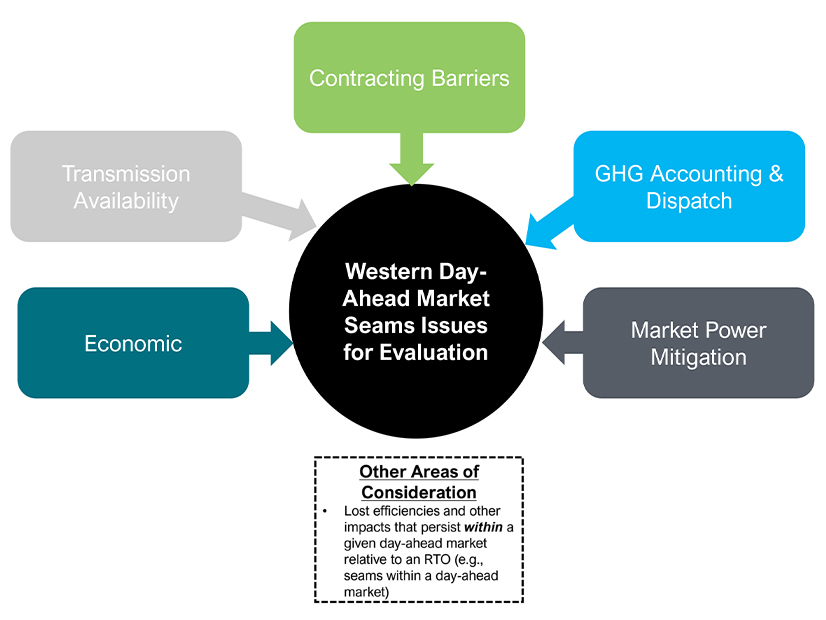
The study finds dividing CAISO’s EDAM from SPP’s Markets+ would create seams that pose a different set of problems than challenges seen at the boundaries of full RTOs in other parts of the U.S.
A new study finds that the seams dividing CAISO’s Extended Day-Ahead Market (EDAM) from SPP’s Markets+ in the West would pose a different set of problems than challenges seen at the boundaries of full RTOs in other parts of the U.S.
The Seams Evaluation study was commissioned by the Western Power Trading Forum (WPTF) and Public Generating Pool (PGP) and prepared by Energy Strategies and Gridwell Consulting.
The study seeks “to provide a framework for understanding the key seams areas and seams issues that may exist between the two proposed day-ahead markets in the West,” while not taking a position on whether the region should have one or two day-ahead markets.
The authors also said they did not intend “to propose specific solutions to seams issues” or provide a comprehensive assessment of all potential issues.
The study lays out how the two day-ahead markets proposed for the West are “fundamentally different” from RTOs in the East.
Those differences include the fact that, unlike the day-ahead markets, the RTOs feature the consolidation of balancing authorities and full participation of entities within the BAs; fully coordinated resource adequacy; and consolidation of transmission planning and generator interconnection to the grid.
The day-ahead markets also would lack full co-optimization of energy deliveries and ancillary services and would require consolidation of open-access transmission tariffs to completely optimize use of transmission.
Seams Within Seams
A key challenge Western day-ahead markets likely would share with Eastern RTOs is the issue of “economic” seams, which arise when boundaries between markets hinder the most cost-effective dispatch of energy across the grid and prevent operators from managing transmission congestion to the greatest extent possible.
To mitigate the impact of economic seams, neighboring RTOs use interface pricing to help facilitate energy flows between them in both the day-ahead and real-time market. The study points out that RTOs also address their boundaries with additional tools, such as interchange scheduling, day-ahead firm flow entitlement exchange, coordinated transaction scheduling and market-to-market coordination.
“While the West should be able to build on these concepts, these tools are currently untested under the non-RTO day-ahead market frameworks and may not translate directly given the seams within the day-ahead markets,” the study says.
The authors note that the mechanisms RTOs use to manage economic seams are the result of negotiations, agreements and joint design efforts among stakeholders from both markets.
“Additionally, given the nature of day-ahead markets, we expect that there will be more parties and/or more seams agreements required (including between BAs and Market Operators) than is seen in the context of Eastern RTOs,” the study says.
The study also delves into the challenges likely presented by seams within Western day-ahead markets as well as between them. Key among them is that both EDAM and Markets+ lack mechanisms for co-optimizing awards for ancillary services with day-ahead energy, although the study acknowledges that could change in the future.
Another internal seam stems from the fact that both day-ahead markets as proposed will allow their BAs to continue to use existing constraints to ensure that market participation doesn’t compromise their reliability obligations, effectively allowing for voluntary participation in the markets.
“This may affect the extent to which BAs rely on the market for imports and commit units within their own footprint, which can reduce overall benefits through lack of full optimization of the fleet,” the study finds.
Another key internal barrier will be the lack of a common resource adequacy framework. Participants in both EDAM and Markets+ will have the option of either joining the Western Power Pool’s Western Resource Adequacy Program or not committing to any RA program at all, while California utilities will continue to be subject to that state’s RA requirements.
“Given the lack of a consistent RA and full [must-offer obligation], other mechanisms must be designed to address sufficiency of resources by individual market participants or BAs in a day-ahead market,” the study says.
Western Challenges
The study also explores potential seams issues specific to day-ahead markets in the West, including increased barriers to contracting for resources, with the boundary between the markets possibly introducing new complexities to contracts, raising costs and increasing risks around deliveries.
Greenhouse gas accounting and dispatch inefficiencies would represent another key barrier between the two markets, according to the study. These would “result from the absence of a single day-ahead market to produce coordinated GHG pricing signals and establishment of similar treatment to all imports into GHG-regulated areas, even under linked carbon pricing programs,” the study says. California and Washington currently operate under separate GHG cap-and-trade programs, but efforts are underway to link them within the next couple of years.
Different approaches to market power mitigation could create yet another type of seam between Western markets, the study finds. The authors point to the increased potential for “higher instances of uncompetitive conditions due to optimizing over two smaller footprints as opposed to one larger footprint.”
They also caution that Markets+ is in the process of developing a balancing authority area-level mitigation system that could differ from what CAISO already has in place for the Western Energy Imbalance Market.
“Creation of two ways to address system/BAA-level market power mitigation will naturally result in areas being exposed to differing levels of over- and/or undermitigation,” the study said, noting that the differences could result in differing levels of contracting for resource among the markets.
The WPTF/PGP study should contribute to discussions about day-ahead market seams already taking shape in the West. At a recent meeting of the Markets+ Participants Executive Committee, supporters of both markets spoke about the need to begin addressing the reality of a divided region. (See SPP Markets+ Participants Executive Committee Briefs: Jan. 23-24, 2024.)
WPTF and PGP will host a webinar to discuss the seams study Feb. 6.


